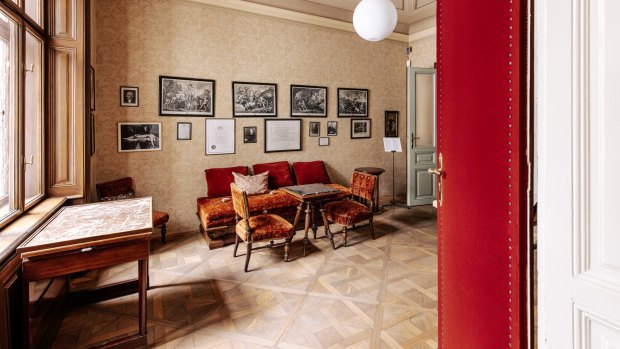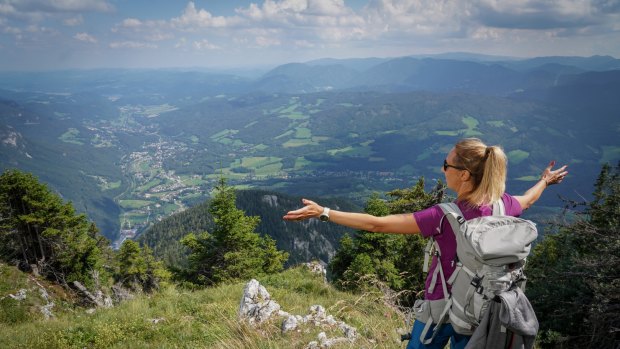This was published 1 year ago
Freud and Frankl in Vienna and surrounds: Where the theory of dreams took root

The Freud Museum.Credit: Paul Bauer
High on a hill above Vienna, as the city drowsed in the midsummer warmth and the late 19th century loped to a close, the secret of dreams was revealed to psychoanalyst Sigmund Freud. Slumbering at the Bellevue Hotel on the northern outskirts of the city, he was visited in a dream by a troubled patient, Irma. What meaning could this vision foretell, he wondered upon waking? As the city clattered to life below and the meadow shook off its dewdrops, Freud's famous Interpretation of Dreams took root.
The hotel on the Bellevuewiese is long gone, but a plaque commemorates the theory that originated here in 1895. The outlook offers a suitably broad perspective of this cultured, intellectual city; far below, in the Freud family's apartment at Bergrasse 19, the granular detail comes into focus. Within these rooms, Freud's theory of dreams – wish fulfillment, he concluded – was refined and transcribed for a rapt audience. Patients like Irma would routinely climb the marble staircase to the apartment and recline on the esteemed psychoanalyst's couch. When Nazi Germany annexed Austria in 1938, the Freuds fled to London, taking their possessions with them.
"I'm sorry to disappoint you but the couch is not here," says guide Bettina Althof as she welcomes me into the apartment, now the Sigmund Freud Museum.

Viktor Frankl regularly spent time in the Viennese Alps, about an hour outside the city.Credit: Roman Zach-Kiesling
"We do have the floors, we do have the walls, but the furniture is not here."
This absence speaks volumes: it is both Holocaust memorial and psyche swept clean. The museum was renovated in 2020; the crisp white walls, parquet floors and extensive exhibits embody 47 years of a life lived and a work accomplished here (the fabled couch can be viewed at the Freud Museum London).
An imperceptible thread runs through the ninth district from Freud's apartment to the scalloped building in which fellow psychiatrist Viktor Frankl lived for half a century after being liberated from a concentration camp in 1945. The two men had begun corresponding when Frankl was in school; both were Jewish, both enjoyed hiking in the Viennese Alps south of the city. While Freud eluded the Nazis, Frankl was the only member of his family – bar a sister who'd escaped to Australia – to survive the camps.
Back in Vienna, amid the stately homes on Mariannengasse, Frankl developed the Third Viennese School of Psychotherapy (after Freud's and Alfred Adler's) and wrote his seminal book, Man's Search for Meaning. His widow Eleonore still lives here; the neighbouring apartment houses the Viktor Frankl Museum. The polished staircase leading to the entrance is reminiscent of Freud's dwelling; but where the former is largely a repository of the past, the latter is a lodestar for the future: sensory, interactive exhibits decipher Frankl's theory of logotherapy, founded on the principle that meaning is humankind's chief motivation.
"Frankl's work and tools are still so important today in how we respond to crisis," says guide Susanne Blach.
We cross a vestibule lit with words: social background, environment, failure, success. Beyond these dimensions lie the abstract concepts of freedom, free will and meaning.
"Frankl says meaning motivates man," Blach says. "It's up to us how we determine and apply it."
Such existential questions occupied Frankl on his regular visits to the Rax mountain range in the Viennese Alps, an hour's drive from Vienna. Escaping his busy life as a hospital director and leader of a global psychotherapy movement, he'd unconsciously retrace the steps Freud himself had once taken here.
"It was like coming home," says Michael Holzer, co-author of Mountains and Meaning, which tells of Frankl's deep love for this environment. "When he came here he was a private man."
The town of Richenau an der Rax is drowned in palls of fog in the valley far below as we ascend the Rax in a cableway and set off along the path Frankl would walk on his way to a daunting cliff-face, Preinerwand.
"What he liked was this contemplation, to walk over the plateau in contrary to the action [of climbing] the wall," Holzer says.
That cliff-face became a metaphor for adversity and the drive to overcome it; the acrophobic Frankl became adept at hauling himself to the top. From up there he would've seen a world that mirrored the psyche: an infinite tumble of sunlit peaks and shadowed valleys.
We come full circle at Ottohaus, the inn where Frankl stayed on his early visits to the Alps. Half a century earlier, Freud visited too; indeed, here he encountered his first "hysteria" patient, the innkeeper's daughter. Today the hut is a welcome respite from the drizzle; it's dense with the scent of stewed lentils and bread dumplings and frothy beer. These floorboards once creaked with Freud and Frankl's footfall. Now their old souls peer in at the windows, dancing on the mist as if in a dream.
Catherine Marshall was a guest of the Austrian Tourist Office and Qatar Airways.
THE DETAILS
FLY
Qatar Airways operates daily flights from Sydney and Melbourne to Doha, with regular connections to Vienna. See qatarairways.com
STAY
Rooms at Vienna Altstadt start from $262 a night. See altstadt.at. Private rooms with shared facilities at Ottohaus start from around $65 a night. See raxalpe.com/gastronomie-huetten/ottohaus/zimmer-preise-im-ottohaus
VISIT
Entry is $20 for the Sigmund Freud Museum and $12 for the Viktor Frankl Museum. See freud-museum.at/en; franklzentrum.org/english/viktor-frankl-museum-vienna.html. The Viennese Alps are accessible from Vienna by road or rail. See oebb.at/en. Rax Cableway transports visitors from Reichenau an der Rax to the trailhead; Ottohaus is a 45-minute walk away. See raxalpe.com
Sign up for the Traveller Deals newsletter
Get exclusive travel deals delivered straight to your inbox. Sign up now.